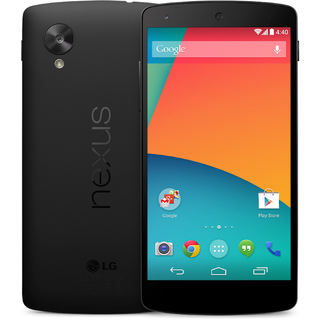Oppo N1 Review: Future-Looking Phablet Or Oversized Flop?
Oppo's N1 sports a unique pivoting camera, a large-format display, and two different operating system options. Are those features enough to make up for an older hardware platform and dicey software optimization in a sea of compelling competition?
Why you can trust Tom's Hardware
Results: GFXBench 3.0
Kishonti GFXBench 3.0 is a cross-platform GPU benchmark supporting both the OpenGL ES 2.0 and OpenGL ES 3.0 APIs. It comprises both “high-level” game-like scenarios, along with more “low-level” tests designed to measure specific subsystems.
The OpenGL ES 2.0-level T-Rex HD, a holdover from GFXBench v2.7, simulates a modern game using several complex effects, including motion blur, parallax mapping, and complex particle systems.
The low-level tests include Fill, which measures fill rate by rendering four layers of compressed textures; Alpha Blending, a test that renders layers of semi-transparent quads using high-resolution, uncompressed textures; ALU, for measuring shader compute performance; and Driver Overhead, which measures the CPU overhead of the graphics driver and API by making a lot of draw calls and state changes. See GFXBench 3.0: A Fresh Look At Mobile Benchmarking for a complete test-by-test breakdown of this benchmark.
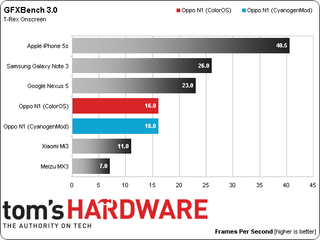
In the synthetic tests we’ve seen so far, the Adreno 330 and Rogue GPUs offer similar performance. However, in the T-Rex benchmark, which attempts to demonstrate the performance of a typical, modern game, the iPhone’s Rogue crushes the Adreno 330 in the Note 3 and Nexus 5. Its score, no doubt, is boosted by rendering the fewest number of pixels.
The N1 manages to finish ahead of both the Mi3 and MX3, but is 2.5 times slower than the iPhone 5s and 1.6 times slower than the Note 3. In this real-world gaming test, there’s no performance difference between ColorOS and CyanogenMod.

Taking the T-Rex rendering off-screen doesn’t change the order at the top of the chart, but does significantly close the gap to the iPhone 5s. With everyone processing the same number of pixels, we again see very similar performance between Adreno 330 and Rogue.
Even though the MX3 and Mi3 render the same number of pixels on- or off-screen, they both see a frame rate increase when rendering off-screen, and even swap positions in the rankings. It appears Samsung’s Exynos 5 Octa and Nvidia’s Tegra 4 encounter a bottleneck between the frame buffer and display.

Rogue’s poor fill rate performance holds the iPhone 5s back in this test, allowing the Note 3 and Nexus 5 to claim the top spots. Even the slower Adreno 320 in the N1 is competitive with Rogue. For comparison, the N1 is about 1.5 times slower than the Note 3. The performance differential between the Adreno 320 and 330 seems to be hovering around 1.5x.
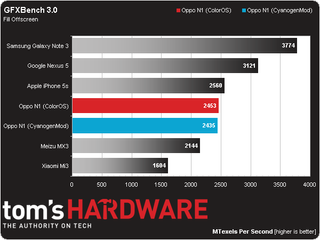
Running the Fill test off-screen produces results virtually identical to the on-screen benchmark.

Once again, Rogue’s poor fill rate performance holds the iPhone 5s back. The results in this metric essentially mirror those in the Fill test, which makes sense due to the functional overlap between them. Even the 1.5x performance delta between the N1 and Note 3 remains.
The only real difference is the Mi3, where the 1.3x deficit between it and the MX3 in the Fill test grows to 2.4x in Alpha Blending. It’s possible the Mi3 is using slower RAM. While I was unable to determine the speed rating of the SK Hynix module, the Geekbench 3 Memory test helps corroborate my theory. In the Single-Core test, the performance delta between the Mi3 and MX3 is again 1.3x, and in the Multi-Core test, where memory bandwidth is further taxed, the delta grows to 1.5x. The Alpha Blending test requires even more bandwidth, so it makes sense that the Mi3 performs worse.
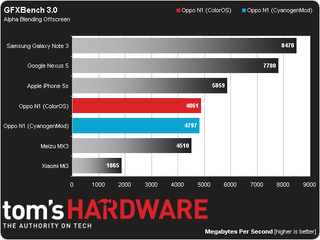
Again, there’s no real change when running this test off-screen.
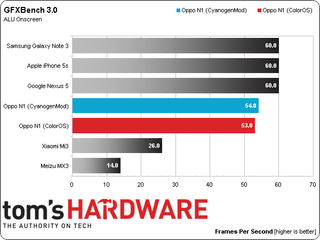
The on-screen ALU test is v-sync limited; the iPhone 5s, Nexus 5, and Note 3 all max out. The N1 comes close to the ceiling, but the Mi3 and MX3 fall significantly behind.
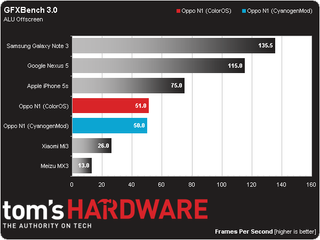
Rendering off-screen removes the v-sync constraint and yields more interesting results. The Adreno 330 shows off its shading prowess, easily defeating Rogue. The Note 3 is 1.17 times faster than the Nexus 5 and 1.79 times faster than the iPhone 5s. The N1, Mi3, and MX3 all fail to improve their scores.
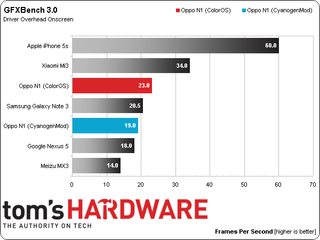
The Driver Overhead test shows the iPhone 5s with nearly twice the performance, or almost half of the overhead, of the Mi3 in second place.
The N1 registers 21 percent less overhead when running ColorOS than CyanogenMod. Perhaps Oppo includes some driver tweaks to help performance. If so, they don't produce any tangible benefits in graphics performance.
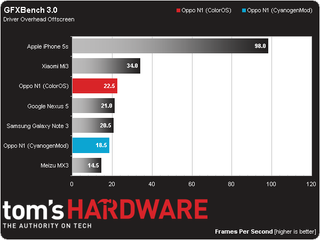
The off-screen results are nearly identical, except the iPhone 5s manages to improve its already-impressive score.
Current page: Results: GFXBench 3.0
Prev Page Results: GPU Core Benchmarks Next Page Results: GPGPU BenchmarksStay on the Cutting Edge
Join the experts who read Tom's Hardware for the inside track on enthusiast PC tech news — and have for over 25 years. We'll send breaking news and in-depth reviews of CPUs, GPUs, AI, maker hardware and more straight to your inbox.
-
wavetrex Just a small comment about OLED, even if this might not be the place to write about it.Reply
Probably due to to imperfections in the transistors that control the OLED pixels, there is a very faint but perceptible in deep darkness leakage of energy toward the pixels.
Yes, doesn't compare to the obvious light bleed of any TFT display, but the OLED "off" pixels are not truly off, they have a 0.00something-small level of light which could theoretically be measured by some very sensitive equipment.
The eyes are certainly capable of seeing it... -
InvalidError Putting both flash LEDs on the same side so close to the image sensor seems like a missed opportunity to me: putting one LED close to each hinge with the camera in the middle would provide more even lighting and softer shadows.Reply
With the mostly passable image quality, that would not help the N1 much though. -
Onus Please don't put the letters "p" "h" "a" "b" "l" "e" "t" together in that order and treat it like a word.Reply
-
WyomingKnott @onusReply
First time I read the term I had the image of holding my 10" Asus pad up to my face and talking into it. I suppose it's better than a shoe; cleaner, too. -
shahbaz200 Bad GPU, doesn't works well on this device, poor performance, other than that its good device.Reply -
BlankInsanity please respect my opinion, but I don't see why phones need to go bigger. i the 90s phones used to be huge and this was a problem for mobility and so as the years went by they created smaller form factor phones. Now here we are repeating that mistake. A phone is ment to make a small footprint when hidden on it's user such as a pocket. You don't put your tablet in your pocket, I don't see why'd you make a phone out of it. this is just my opinionReply -
jankeke "please respect my opinion, but I don't see why phones need to go bigger. i the 90s phones used to be huge and this was a problem for mobility and so as the years went by they created smaller form factor phones. Now here we are repeating that mistake. A phone is ment to make a small footprint when hidden on it's user such as a pocket. You don't put your tablet in your pocket, I don't see why'd you make a phone out of it. this is just my opinion "Reply
True but people couldn't watch porn on their phones back then so it made sense to make them as small as possible. Not so now ... ^^ -
Matthew DiGiacomo No offense Tom's Hardware but why are you reviewing this phone now? It's outdated and been on the market for almost 8 months.. No one really cares about it anymore.Reply -
falchard The Camera is a smart solution meaning you won't need 2 cameras. Obviously it will need tilt support to tell it which direction is up.Reply
No removable battery is a shitty solution. Its the issue all phones face after 2 years, their batteries no longer hold a charge. -
BlankInsanity Reply13717317 said:The Camera is a smart solution meaning you won't need 2 cameras. Obviously it will need tilt support to tell it which direction is up.
No removable battery is a shitty solution. Its the issue all phones face after 2 years, their batteries no longer hold a charge.
lol that's a scam the companies do to force you to buy a new one ;)


